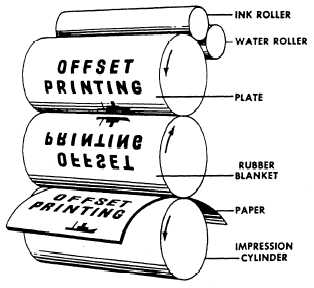CHAPTER 8
PRINTING, LAYOUT AND MAKEUP
Despite the popularity of radio and television, the
Navy and the public-at-large are very much
print-oriented. All large ships and stations and many of
the smaller Navy commands publish newspapers or
magazines regularly. Consequently, as a Navy
journalist, you can expect to be tasked with editing or
assisting in the production of such a publication.
Should you somehow miss out on this challenging
opportunity, a number of other items requiring an
editor’s skills and knowledge will likely surface on your
desk some morning. Among these highly probable
assignments are familygrams, change of command
programs, public visitation brochures and cruisebooks.
Therefore, the information in this chapter, while
directed primarily to potential newspaper editors, also
is intended to acquaint you with the fundamentals and
terminology of printing and the mechanics of laying out
and making up copy for the publisher. Tips on designing
Navy newspapers for a contemporary audience are
included in this section, as well.
OFFSET LITHOGRAPHY
LEARNING OBJECTIVE: Recognize the
principle of offset lithography, its paste-up
process, and the types of artwork used in
photo-offset printing.
Offset lithography is the most preferred method of
printing in both the civilian and military communities.
Today, more than 90 percent of the nation’s newspapers
and closer to 95 percent of the larger service
publications are products of offset presses.
Based on the principle that oil and water do not mix,
offset lithography uses a flat-surface plate in its printing
process. In offset printing, the plates are prepared
through a technical photochemical process that leaves
the nonprinting areas of the plate receptive to water.
On an offset press, two sets of rollers pass over the
plate cylinder. One spreads water over the plate. Only
those parts representing white space remain damp. The
second roller spreads ink that only sticks to the parts of
the plate that are dry. The plate then passes against a
rubber-covered “blanket” cylinder that accepts the
Figure 8-1.—The process of offset lithography.
inked image. The blanket cylinder “offsets,” or
transposes, the image to the paper which is carried
through the press and pressed against the blanket by an
impression cylinder. This process is shown in figure 8-1.
PHOTO-OFFSET COPY
Let’s now evaluate what must be done to prepare
copy for photo-offset equipment.
The set copy is mounted, along with line art, on a
paste-up (layout sheet) for photographing. The way art
and type are mounted on the paste-up has a great effect
on the quality of the finished product. Take care to avoid
shadows and wrinkles. If possible, make the paste-up to
the actual size of the newspaper.
In some cases, a Navy editor may only indicate the
sizes and positions of the various elements on the layout
sheet and then let the publisher position them
accordingly. However, you can save much time and
effort when you make the complete paste-up yourself.
It is easier for’ you to cut and paste the paper than it is
for the publisher to work with the photographic
negatives and positives for final assembly.
You will need the following items for the paste-up
operation:
8-1



